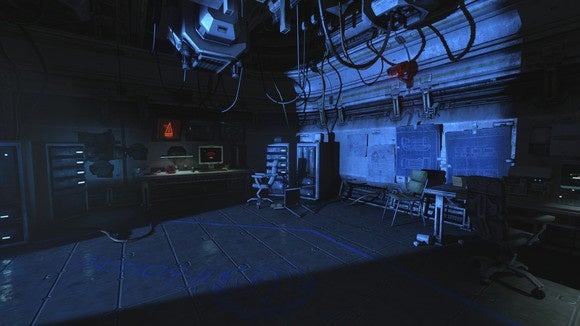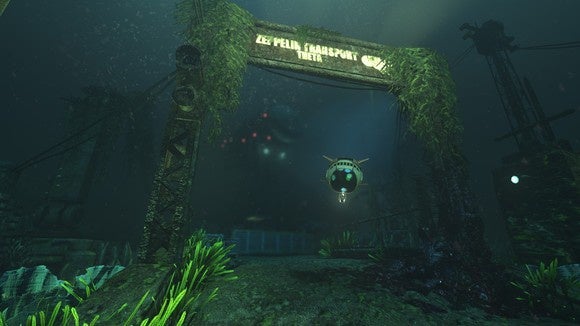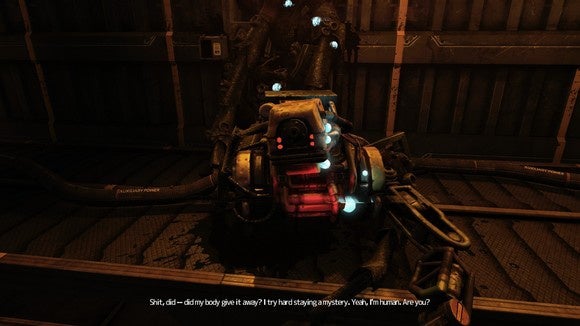Strict Standards: Only variables should be assigned by reference in /home/noahjames7/public_html/modules/mod_flexi_customcode/tmpl/default.php on line 24
Strict Standards: Non-static method modFlexiCustomCode::parsePHPviaFile() should not be called statically in /home/noahjames7/public_html/modules/mod_flexi_customcode/tmpl/default.php on line 54
Strict Standards: Only variables should be assigned by reference in /home/noahjames7/public_html/components/com_grid/GridBuilder.php on line 29
It’s appropriate that the first words you’ll see in SOMA are a quote by the late science fiction visionary Philip K. Dick. Sure, the quote—“Reality is that which, when you stop believing in it, doesn’t go away”—pertains to the story you’re about to experience, but that’s not what I mean.
The quote is an appropriate opening because SOMA feels like a piece of classic science fiction—something that would’ve come out of Harlan Ellison or Ray Bradbury or, yes, Philip K. Dick.
It’s a story you might’ve seen in grainy black and white on Twilight Zone or maybe The Outer Limits. It is bits of Blade Runner, of Demon with a Glass Hand, of I Have No Mouth and I Must Scream and The Martian Chronicles and The Three Stigmata of Palmer Eldritch and so many other legendary works of science fiction. It’s a story that deals with that most human of all topics: What does it mean to be human?
NOTE: I’m going to try not to spoil anything in this review that wasn’t already covered in the game’s trailers, but be warned there are minor plot points ahead.
20,000 leagues
Most importantly, it’s the first time Frictional has developed a game where its output matches its ambitions.

That’s not meant as a slight on Frictional’s previous work. In fact, it’s testament to the studio’s creative talent that both Penumbra and Amnesia became staples of the horror genre despite the obvious constraints of limited budget and personnel.
SOMA is something more though. It’s barely even a horror game, for starters. If you’re looking for another experience as overtly terrifying as Amnesia, look elsewhere. There are certainly horror elements to SOMA. There are dark corridors and blood splatters and things that go clank in the night. There are even monsters, of a sort.
But SOMA is mostly psychological—more first-person adventure game than first-person horror. After briefly playing the game at E3 I said SOMA seemed full of existential dread, and that remains true after ten hours with the game.
[FINAL SPOILER WARNING – AGAIN, ONLY THINGS COVERED IN TRAILERS]

SOMA takes place in (and sometimes outside of) PATHOS-II, an underwater laboratory far below the surface of the Atlantic Ocean. At one point PATHOS-II was a thriving facility, but now it’s mostly inhabited by robot…things. I mean, they look like robots, but they talk like people. They think they are people. They can hold conversations. They remember their lives. They feel pain. They can hate.
You play as Simon Jarrett, who—no surprise—wants to get the hell out of PATHOS-II before the robots turn on him or the station falls apart. Good luck.
Like I said before, the game is mostly a first-person adventure. Frictional still tosses in the occasional enemy—and their designs are as unnerving as ever—but encounters are far less pervasive than they were in, say, Amnesia, where you spent 90 percent of the game crouched and creeping through shadows.

Instead, SOMA goes for quality over quantity. While Amnesia featured tons of rank-and-file monsters, most anyone will tell you the “Water Monster” was the most memorable part of the game. The Water Monster (or “Kaernk”) in Amnesia was a special encounter in a flooded basement—an invisible monster you could only track by watching where the water splashed. And it was memorable because it was unique.
While I don’t think any adversary in SOMA quite reaches that level of genius, it’s clear Frictional took a different approach to the game, utilizing bespoke, one-off enemies instead of a single creature repeated ad infinitum. The result is threefold: Unforgettable moments, better pacing, and less mindless repetition.
But most of your time with SOMA involves exploring PATHOS-II. It’s a character in itself, separate from the crew. Its groans and metallic creaks keep you company during long stretches of isolation. Its cold green lights start to feel like a warm, familiar hug after five minutes traversing the barren ocean floor. The hiss of an airlock sounds like someone welcoming you home.
And when the lights go out, you know it’s time to hide. Or run.
Immersed
Post-E3, I made the obvious comparison—SOMA is like BioShock. After all, they both take place underwater and they both take a stab at telling a “real story” instead of the usual video game tripe. I’m amending that though, because the truth is SOMA does BioShock better than BioShock ever did BioShock.

It’s like a trail diverged in the woods, and two separate-but-yet-extremely-similar games sprung from System Shock 2. One designed a story around the need for, as Ken Levine put it, “a skill component” (a.k.a. guns), and became BioShock. The other eschewed combat, focusing instead on System Shock 2’s world-building and the potential of telling a story in the first-person perspective. Thus, SOMA.
There are sequences in SOMA that only work because this is a video game, and more specifically, a first-person game—real gut-punches that only hit because you are inhabiting a character. A few bits make such expert use of first-person perspective I’m reminded of the original Call of Duty: Modern Warfare which, before the series became a parody of itself, wowed an entire industry with its audacious manipulation of point-of-view.
But where Modern Warfare used it for spectacle, SOMA uses it to mull on various crises of conscience. To isolate you. To sit and reflect amidst the groaning of pressurized steel and billions of gallons of water churning above your head. Again, all in service of one pervasive question: What does it mean to be human?
Bottom line
SOMA is not the horror game I expected out of Frictional, but I don’t care and it doesn’t matter. This is an excellent work of science fiction, not necessarily unique but uniquely told through its skillful use of video game conceits. It’s System Shock 2 for a modern sensibility, BioShock freed of its AAA chains. It’s damn good and, for my money, the most cohesive and ambitious game Frictional’s made so far.
I leave you with another Philip K. Dick quote—the mirror to SOMA’s opening: “It is sometimes an appropriate response to reality to go insane.”

Strict Standards: Only variables should be assigned by reference in /home/noahjames7/public_html/modules/mod_flexi_customcode/tmpl/default.php on line 24
Strict Standards: Non-static method modFlexiCustomCode::parsePHPviaFile() should not be called statically in /home/noahjames7/public_html/modules/mod_flexi_customcode/tmpl/default.php on line 54
Find out more by searching for it!
